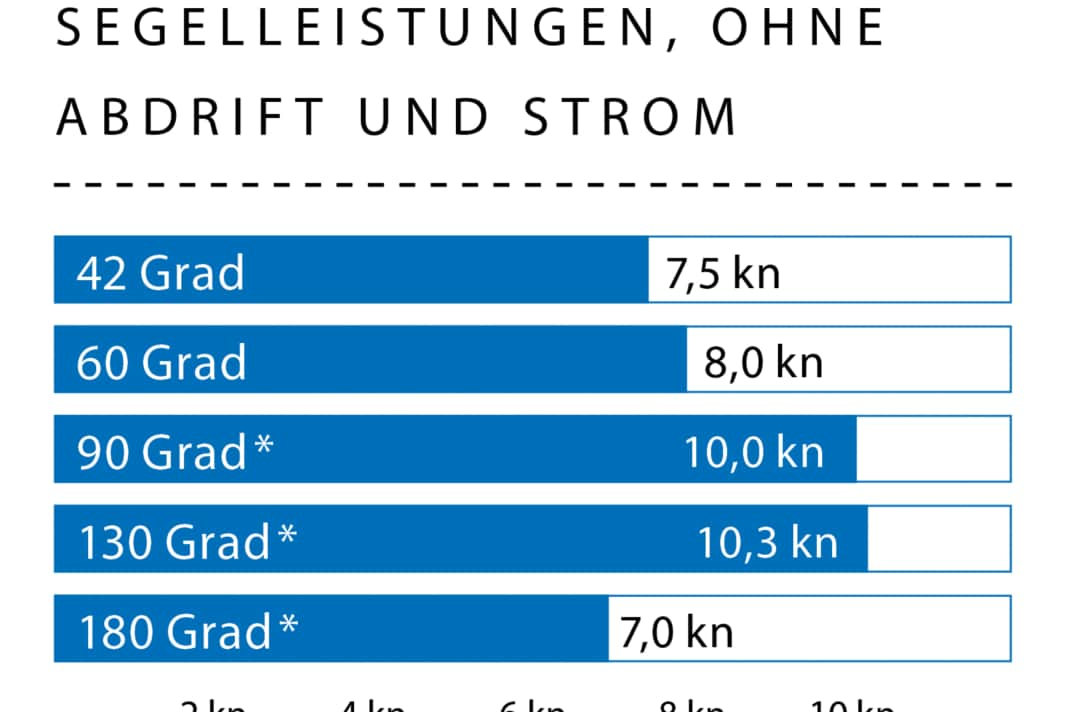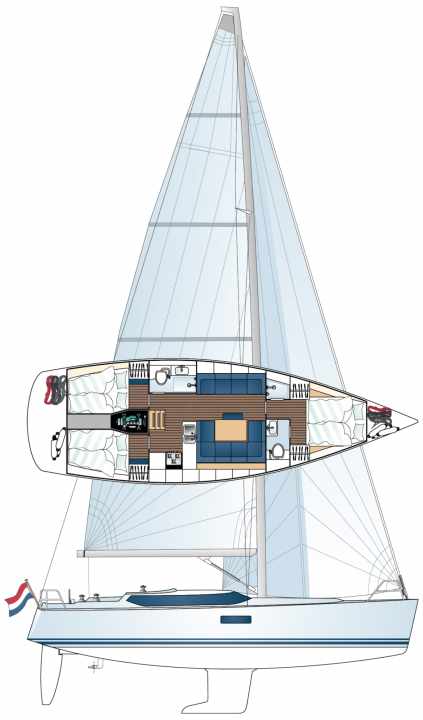





Exactly 200 kilometres per hour - that is the top speed stated by VW for the top model of its Multivan, a large-capacity saloon. The rival Mercedes model, the Viano, has a top speed of 217 kilometres. Not exactly slow for such large vehicles with a comfortable, high seating position. The vehicles have up to seven seats on request, also available in leather, multimedia sound systems, cool boxes and, of course, air conditioning and auxiliary heating. In short: everything that makes fast and long journeys pleasant. Those who arrive earlier will find a better parking space and get more out of the day.
Read more about the shipyard:
So if car manufacturers screw large engines into a comfortable motorhome so that it can get down to business, why not put a veritable rig into a comfortable tourer? Even the eleven tonnes of a Contest 42, which is probably more like 13 tonnes when fully equipped and with a full tank, should be fast if the design comes from the pen of the experienced Georg Nissen and the drive - not the diesel here - plays along.
So: if desired, a carbon mast can be fitted, preferably through-battened, a lead keel, which is fitted as standard in Contest anyway, can be hung low in the water and the sailmaker at North can fire up the laminating machine. A torsion-resistant, vacuum-injected hull with balsa core is then helpful. Et voilà: Off you go. Even with six berths, teak deck, two real wet cells, thick batteries and a generator. At least that's the theory.
Can also be sporty
Construction number 1 was deliberately equipped by the shipyard with everything that makes it fast in order to prove that it works. And to sail regattas with it. "We want to show that fast travelling - or even a regatta - is also possible with comfortable tourers. The performance version is just one of various options for customising the boat to your own needs," says Marcel Offereins, Head of Sales at Contest, giving an insight into the considerations during the design phase.
There are 45 variants for the layout below deck alone. There are a further five for the cockpit layout. Then there is the choice of the right rig. In short: a concept that offers many possibilities. This is new for the shipyard, at least in the recent past.
This is because the larger models are fully customised. As long as it fits into the hull, the customer gets what he wants. But the 42 has to produce larger quantities, even a small series. Customisation is achieved through the enormous variety of layouts.
"It is built in exactly the same way as a 72, for example, only the customisation is done a little more via the expansion variants. But it remains a real contest," says Offereins. This makes the Dutch model a welcome exception on the market. An XC-42 offers two versions, Hallberg-Rassy's 412 offers four. Both of these boats have their cockpit aft. As does the 42 CS.
Another novelty for the shipyard: "Yes, it is the first Contest in a long time with an aft cockpit. But we think that the cockpit in the centre only works from around 45 feet upwards due to the space below deck," says Offereins. The decision is a good one for the new boat: elongated lines, an almost flat foredeck and an eye-catching raised saloon roof. The effect is almost Wallyesque - even though it is "only" 42 feet.
Premiere under sail
But enough theory: now she has to show what she can do. Everyone present at the test is very curious about the sailing characteristics. This also applies to the shipyard representative, who is also excited about the performance: "It was the same as always with the number 1 - it was only finished shortly before the trade fair in Amsterdam. Too short: we didn't have time to test it. It was just a case of switching on the engine and getting to the first trade fair appearance in the capital as quickly as possible."
Incidentally, this is evidence of the shipyard's healthy self-confidence: the first sailing trip with the YACHT on board. You have to be sure of yourself. Frans Hinfelaar is on board as a reinforcement. He is an Admiral's Cup veteran and now head of North Sails in the Netherlands, and the 3Di sails come from his people. As soon as they arrive on the Markermeer, they go up. But nothing helps: without wind, even the best sails won't do. There are squalls in the sky all around, what they call "dark air" in Holland. But nothing is moving on board. So: wait. Fortunately not too long.
Measurement results of the Contest 42 CS




The first gusts arrive, the wind picks up and the new Contest with it. In 16 knots of wind, she is making just under 8 knots at around 40 degrees downwind. Hinfelaar pumps the hydraulic backstay in gusts: "You need that for optimum trim in the main." The traveller is just as helpful. It runs either over the cockpit floor in the Performance version or on the coachroof in the Performance Cruising version. The third alternative without a rail is the short-handed version. Then you need the hydraulic downhaul, which comes on board together with the backstay.
It's already thundering, but the crew is still curious to see what the new one can do. So: gennaker up! The 94 square metres pull, the log quickly shows double digits, and that on the shallow Markermeer. In the deeper channel, the display climbs a little. Full control on the wheel. What would it be like on the North Sea now, with deep water, space and waves? Whatever. Here too, the Contest is fun, it runs stubbornly straight ahead and obeys every steering command. Autopilot-friendly.
When the wind display on the carbon mast suddenly fails, the crew is reminded of the approaching storm. So they lower the bubble, just in time, and then the shower starts. It wasn't a real test, the net sailing time was too short, more of a taster. But: she can do it, sailing, the Contest 42.
Fortunately, YACHT also had the opportunity to sail construction number 2 with a normal rig and without a traveller, i.e. in the aforementioned short-handed version, as part of the 2014 European Yacht of the Year competition off Southampton. Although the conditions were not really challenging, colleague Michael Good attests to the boat's "pleasingly good sailing characteristics, even in light winds".
Modern and cosy
Back on the Markermeer, there is time for a tour below deck. It is bright there. This is partly due to the large strip of windows in the superstructure, partly due to the hull windows in the saloon and partly due to the materials used. Oak with white wash, a type of chalking, dominates the interior. This was a customer request; teak is standard. The wall units in the galley are plain white. Not to everyone's taste, but certainly practical as they are easy to clean and light in colour. And, like so many things, can be changed on request.
The aft berth dimensions are not variable. If you choose two aft compartments, they are acoustically separated from each other by a wide tunnel in the extension of the engine compartment. There is space in the tunnel for installing the generator and other equipment. However, as the 42 does not have an overly projecting stern, there is only 1.40 metres of width left at the shoulders of the berths.
This is just the minimum size that a double berth should have. The length and height above the beds are perfectly acceptable. In the foredeck, the bunk in the tested version is spacious. Owner and partner even have 1.76 metres at shoulder height here - in other words, plenty of space. The dimensions of the bathrooms are also pleasant. They work, even with oilskins, and the showers are large enough. Fine.
The wet area in the foredeck is divided. The shower and washbasin are on the starboard side and the toilet on the port side. That's fine. What is missing, however, is sufficient dry storage space. The shipyard wants to improve this. There was also a lack of ventilation in the toilet room. In this layout, the deck hatch is installed next to the room and, as is well known, no hatches that can be opened may be installed in the hull. An electric extraction system is the solution that will be used from now on.
Ventilation: There are many hatches in the deck, but none on the sides. This is due to the design: as the surrounding light strip should not be interrupted, no hinged windows are installed - cross-ventilation is therefore not possible. However, anyone planning to travel to hot regions will probably tick the air conditioning box anyway. A compromise.
Hidden quality
What always stands out at Contest are the many details: the doors don't rattle because of special closers, floorboards don't creak, the filters for cooling water and diesel are located in a central position where they are easily accessible. The latter contains a sensor for water in the fuel, and an alarm automatically warns of this.
The bilge pumps are also connected to the alarm system. All sea valves are connected by cable to a central earthing plate, virtually eliminating corrosion. The lines from French manufacturer Lancelin follow a sensible colour concept to avoid confusion during operation. The folding propeller is standard, the components installed are of high quality and not a single screw is visible in the entire interior. Not many yacht builders build at this level any more.
Price of the Contest 42 CS
Anyone who can enjoy such details will also understand why such a ship costs a good half a million euros, albeit fully equipped with electronics and everything that makes travelling pleasant.
- Base price ex shipyard: 1,009,120 Euro incl. 19% VAT.
- Guarantee/against osmosis: 2/5 years
Status 2025, how the prices shown are defined, read here!
The Contest is therefore well within the range of its competitors and yet offers many unique selling points: the design, the variety of options for fittings, colours, wood types and cockpit design as well as the vacuum injection construction with balsa core. She is therefore equipped for fast and comfortable travelling.
YACHT rating of the Contest 42 CS
The Contest 42 CS is a cruising racer. It is characterised by impressive, easy-to-recall sailing characteristics combined with exquisite living comfort and the best workmanship. The initially high price is therefore justified on closer inspection.
Design and concept
High-quality construction throughout
Wide range of variants
No possibility for cross ventilation
Sailing performance and trim
Direct, agile steering feel
Can be trimmed well depending on equipment
Living and finishing quality
Impeccable finish
Berths aft short
Ventilation WC room forward
Equipment and technology
Many very good details
Only high-quality components
Hole point adjustment at an extra charge
The Contest 42 CS in detail

Technical data of the Contest 42 CS
- Design engineer: Georg Nissen
- CE design category: A
- Lüa (torso length): 12,85 m
- Width: 4,15 m
- Draught/alternative: 2,20/1,80 m
- Weight: 11,0 t
- Ballast/proportion: 4,6 t/42 %
- Mainsail: 57,0 m²
- Furling genoa (105 %): 47,0 m²
- machine (Yanmar): 40 kW/54 hp
Hull and deck construction
E-glass and vinyl ester in vacuum infusion with balsa core, stressed areas solid. Bulkheads fully laminated.
Shipyard
Contestyachts, Overleek 5, 1671 GD Medemblik, Netherlands; www.contestyachts.com
The test was first published in 2014 and has been revised for this online version.

